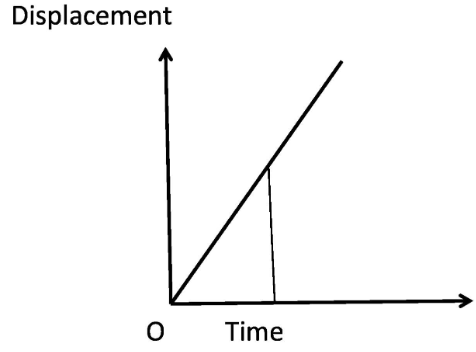
Positive slope of displacement time graph implies:
A) That the body is moving away from the reference point
B) That the body is moving towards the reference point
C) That the body is at rest
D) Nothing as particular
Answer
218.4k+ views
Hint: In order to find the correct option for the given question we need to know about the displacement time graph, the method of drawing the graphs and the method of tracing the paths in the graphs. Also, we need to know the way to draw the slope of the graph. Then, we can conclude with the correct answer.
Complete step by step answer:
Let us find information about the displacement time graph.

With the help of a displacement time graph we can easily show the displacement of a body with respect to time. On the x-axis or we can say that on the horizontal line, we represent the time taken to change the position. On the y-axis or the vertical line, we represent the values of displacement of the body. When we draw the slope under the graph of displacement time, then it shows that the body is moving. In other words we can say that the slope of the graph gives the velocity of the body.
Generally we consider the reference point to find out whether the body is in motion or not. Now, if we get a positive slope, in that case we can conclude that the body is moving away from the reference point. On the other hand, if we get the negative slope, then we can conclude that the body is moving towards its reference point.
From step one; we can conclude that the body will move away from the reference point.
Hence, option (A), i.e. that the body will move away from the reference point is the correct choice.
Note: One should not get confused with the velocity time graph as its slope gives acceleration. In this case, the positive slope gives positive acceleration and the negative slope gives the negative acceleration.
Complete step by step answer:
Let us find information about the displacement time graph.

With the help of a displacement time graph we can easily show the displacement of a body with respect to time. On the x-axis or we can say that on the horizontal line, we represent the time taken to change the position. On the y-axis or the vertical line, we represent the values of displacement of the body. When we draw the slope under the graph of displacement time, then it shows that the body is moving. In other words we can say that the slope of the graph gives the velocity of the body.
Generally we consider the reference point to find out whether the body is in motion or not. Now, if we get a positive slope, in that case we can conclude that the body is moving away from the reference point. On the other hand, if we get the negative slope, then we can conclude that the body is moving towards its reference point.
From step one; we can conclude that the body will move away from the reference point.
Hence, option (A), i.e. that the body will move away from the reference point is the correct choice.
Note: One should not get confused with the velocity time graph as its slope gives acceleration. In this case, the positive slope gives positive acceleration and the negative slope gives the negative acceleration.
Recently Updated Pages
Two discs which are rotating about their respective class 11 physics JEE_Main

A ladder rests against a frictionless vertical wall class 11 physics JEE_Main

Two simple pendulums of lengths 1 m and 16 m respectively class 11 physics JEE_Main

The slopes of isothermal and adiabatic curves are related class 11 physics JEE_Main

A trolly falling freely on an inclined plane as shown class 11 physics JEE_Main

The masses M1 and M2M2 M1 are released from rest Using class 11 physics JEE_Main

Trending doubts
JEE Main 2026: Application Form Open, Exam Dates, Syllabus, Eligibility & Question Papers

Derivation of Equation of Trajectory Explained for Students

Hybridisation in Chemistry – Concept, Types & Applications

Understanding the Angle of Deviation in a Prism

Understanding Collisions: Types and Examples for Students

Understanding Atomic Structure for Beginners

Other Pages
JEE Advanced Marks vs Ranks 2025: Understanding Category-wise Qualifying Marks and Previous Year Cut-offs

Units And Measurements Class 11 Physics Chapter 1 CBSE Notes - 2025-26

NCERT Solutions For Class 11 Physics Chapter 8 Mechanical Properties Of Solids

Motion in a Straight Line Class 11 Physics Chapter 2 CBSE Notes - 2025-26

NCERT Solutions for Class 11 Physics Chapter 7 Gravitation 2025-26

How to Convert a Galvanometer into an Ammeter or Voltmeter




